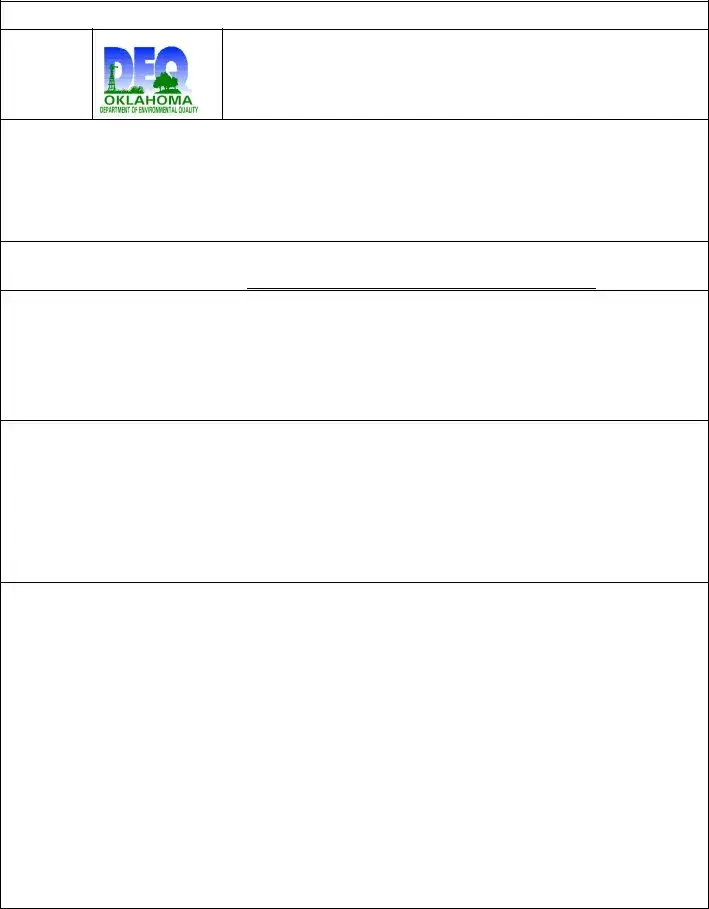See Page 4 for Instructions
DEQ
FORM
605-006
Sept. 5, 2011
Oklahoma Department of Environmental Quality
Annual Comprehensive Site Compliance Evaluation Report
for Industrial Facilities (ACSCER)
Submission of this Comprehensive Site Compliance Evaluation Report, Part B, provides notice that the party identified in Section I of this form is not required to conduct Benchmark Monitoring for storm water discharges associated with industrial activities under the OPDES program. This Annual Comprehensive Site Compliance Evaluation Report is required for all authorized industrial facilities.
All Requested Information Must Be Provided On This Form (Part A) and the ACSCER Form (Part B).
See Instructions On Page 4 of The Form.
Section I.
OPDES Permit Authorization Number:
Section II. Facility Operator Information
Name: ______________________________________________ Phone:_________________________________
Address:______________________________________________________________________________________
City: __________________________________ County:_____________________ Zip Code:__________________
Section III. Facility Location
Name:_____________________________________________________ Phone:____________________________
Address: ______________________________________________________________________________________
City: _________________________________ County: _________________________ Zip Code:_______________
Latitude: ____________________________ Longitude:___________________________
Section IV. Certification
I certify under penalty of law that I have read and understand the requirements for filing this Comprehensive Site Compliance Evaluation Report, which is to be filed by March 1st of each year beginning in 2012.
This report is also to be retained as part of the SWP3 for at least three (3) years from the date permit coverage expires or is terminated and will be made available to any State or Federal Inspector visiting this facility. All records of actions taken in accordance with 4.10 of this permit as part of the Storm Water Pollution Prevention Plan will be retained for at least three (3) years from the date permit coverage expires or is terminated. I certify under penalty of law that this document and all attachments were prepared under my direction or supervision in accordance with a system designed to assure that qualified personnel properly gathered and evaluated the information submitted. Based upon my inquiry of the person or persons who manage the system, or those persons directly involved in gathering the information, the information submitted is to the best of my knowledge and belief true, accurate, and complete. I am aware there are significant penalties for submitting false information, including the possibility of fine and imprisonment for knowing violations.
Print Name: ________________________________________________ |
Date:_________________________ |
Signature:__________________________________________________ |
Title:_________________________ |
1
Annual Comprehensive Site Compliance Evaluation Report - Part B
Page 1.
Reporting Period: ______________________________.
How many routine facility inspections did you perform during the reporting period? ___________
How many corrective actions (Part 4.2.17.3) to remove the original violation and document these actions according to corrective action deadlines?
Date |
Deficiencies |
Corrected (Y or N) |
Date Corrected |
______________ |
_________________________ |
__________ |
____________ |
______________ |
_________________________ |
__________ |
____________ |
______________ |
_________________________ |
__________ |
____________ |
______________ |
_________________________ |
__________ |
____________ |
What must you do to correct the deficiencies that remain uncorrected?
______________________________________________________________________________
______________________________________________________________________________
Were all BMPs you indicated you would be using in your SWP3 (Part 4.2.8) including good housekeeping practices, actually being implemented at the time of the Annual Comprehensive Site Compliance Evaluation? Yes _____ No_____
If one or more BMPs were not being implemented, were corrective actions taken after the FIRST inspection to find the problem?
Yes _____ No_____ |
All BMPs were being implemented ______ |
Was/were the same failure(s) to implement a BMP deficiency(ies) noted in more than one inspection?
Yes _____ No_____ |
No deficiencies noted in any inspection ________ |
Did any of your routine facility inspections find that one or more of your BMPs was not effective in controlling the pollutant source for which it was designed?
Yes _____ No_____ |
All BMPs were effective ______ |
If you found one or more ineffective BMPs, have they all been replaced with an alternative or modified BMP?
Yes _____ No_____ |
All BMPs were being effective ______ |
Is there additional BMPs needed to address any conditions requiring corrective action? Yes _____ No_____
At any time during the reporting period, did you discover any previously unidentified illicit discharges from your facility or previously unidentified pollutants in the existing discharges?
Yes _____ No_____
Have all illicit discharges (including any discovered in previous years) been eliminated or permitted?
Yes _____ No_____ |
Permit applied for ______ No known illicit discharges ______ |
Have any significant spills or leaks occurred at your facility during the reporting period? Yes _____ No_____
If any significant spills or leaks occurred, did they result in either a dry weather discharge or an actual discharge of the spilled or leaked material commingled with storm water (as opposed to the spilled material being washed away by storm water?)
Yes _____ No_____
2
Part B. Page 2
If any significant spills or leaks occurred, did they result in more than the minimum amounts of material being discharged in storm water? Base your answer on your knowledge of the material you spilled or that leaked. The minimum amounts could vary with the nature (toxicity, oxygen demand, pH, etc.) of the spilled or leaked material from amounts left after normal "sweeping" type cleanup to the point at which even trace amounts left
after cleanup could cause an environmental problem.
Yes _____ |
No_____ |
No spills or leaks occurred______ |
Have all known spills or leaks been cleaned up or otherwise prevented from contaminating storm water that
would be discharged under the authority of this permit?
Yes _____ No_____ |
No spills or leaks occurred______ |
How many times did you visually monitor all your storm water discharges at all the facility outfalls during the reporting year, and document the condition of and around the outfalls, including flow dissipation measures to prevent scouring? (Count only those done in accordance with the procedures at Part 5.1 - Quarterly Visual Monitoring)
Yes _____ No_____ |
Number of Visual Monitoring _______ |
Would the results of your visual monitoring indicate that there are pollutants in your storm water discharges that are not adequately controlled by your current BMPs?
Yes _____ No_____
If the results of your visual monitoring indicated a potential problem, was it due to one or more of the following?
1.New pollutant source (including exposure of previously unexposed material).
2.Failure to implement or maintain an existing BMP.
3.Less than expected performance from a BMP.
4.No BMP was selected to deal with that problem.
5.N/A (No problems identified)
If your visual monitoring indicated a potential problem, what have you done to resolve the problem?
1.Eliminated exposure or pollutant source.
2.Modified existing BMPs.
3.Added a new BMP.
4.Plan to address problem by end of current reporting year.
5.Nothing planned.
6.N/A (No problems identified).
Did any analysis of any element tested during any previous discharge monitoring period exceed the numeric limitation value?
Yes _____ No_____
If your answer to the previous question was "Yes", please name the element and the test results.
Element |
Test Results |
Element |
Test Results |
_________________ |
_____________ |
_________________ |
_____________ |
_________________ |
_____________ |
_________________ |
_____________ |
_________________ |
_____________ |
_________________ |
_____________ |
Is there any required revisions to the SWP3 resulting from the inspection?
Yes _____ No_____
Exhibit 5 Annual Comprehensive Site Compliance Evaluation Report - Instructions
Instructions for Completing the Annual Comprehensive Site Compliance Evaluation Report
Form 605-006, Storm Water Discharges Associated with Industrial Activity
When to File an ACSCER Form:
Permittees who are presently covered under an issued OPDES general permit for storm water discharges associated with industrial activity must submit an Annual Comprehensive Site Compliance Evaluation Report by March 1st of each year, beginning in 2012. This is in lieu of filing analytical benchmark discharge monitoring reports. If you need assistance or have questions, contact the Storm Water Program of the Environmental Complaints & Local Services of the DEQ at (405) 702-6100.
Section I: Permit Information:
Enter the existing OPDES General Storm Water Multi- Sector Industrial Permit number assigned to the facility identified in Section II.
Section II. Facility Operator Information:
Give the legal name of the person, firm, public organization or any other entity that owns or operates the facility described in this application. The name of the operator may or may not be the same name as the facility. The operator of the facility is the legal entity that controls the facility's operation, rather than the plant or site manager.
Section III: Facility/Site Location Information:
Enter the facility’s official or legal name and complete address, telephone, city, state, and ZIP code. If the facility lacks a street address, indicate the latitude and longitude of the facility to the nearest 15 seconds.
Section IV: Certification
The ACSCER form must be signed by a responsible party such as the owner or an officer, such as: president, vice president, secretary, and treasurer of either a corporation, company, trust, partnership, or sole proprietorship by a general partner or the proprietor. For a municipality, state, Federal, or other public facility: by either a principal executive officer or ranking elected official.
How to complete the Comprehensive Site Compliance Evaluation Report Part B (see Section 4.2.17)
1.Inspect all areas where materials or activities are exposed to storm water, and areas where spills and leaks have occurred within the past 3 years.
2.Report industrial material, residue or trash on the ground that could contaminate or be washed away.
3.Prevent leaks or spills from industrial equipment, drums, barrels, tanks, etc.
4.Prevent offsite tracking of industrial material or sediment.
5.Prevent tracking or blowing of raw, final, or waste material from areas of no exposure to exposed areas.
6.Include evidence of, or potential for pollutants entering the drainage system.
Corrective Actions (see Part 4.2.17.3):
1.Review to determine if revisions/modifications to eliminate problems or meet the effluent limits in this permit;
2.Document your discovery of any of the conditions listed in Part 4.2.17.3.a and b within 24 hours and any corrective actions to be taken to eliminate or further investigate the deficiency within 14 days of such discovery.
3. Complete the corrective action report with the information included in Part 4.2.17.3.d..
Reporting is required by March 1st of the year beginning in 2012.
Where to file an ACSCER :
DEQ - ECLS
Storm Water Program
P.O. Box 1677
Oklahoma City, Oklahoma 73101-1677


